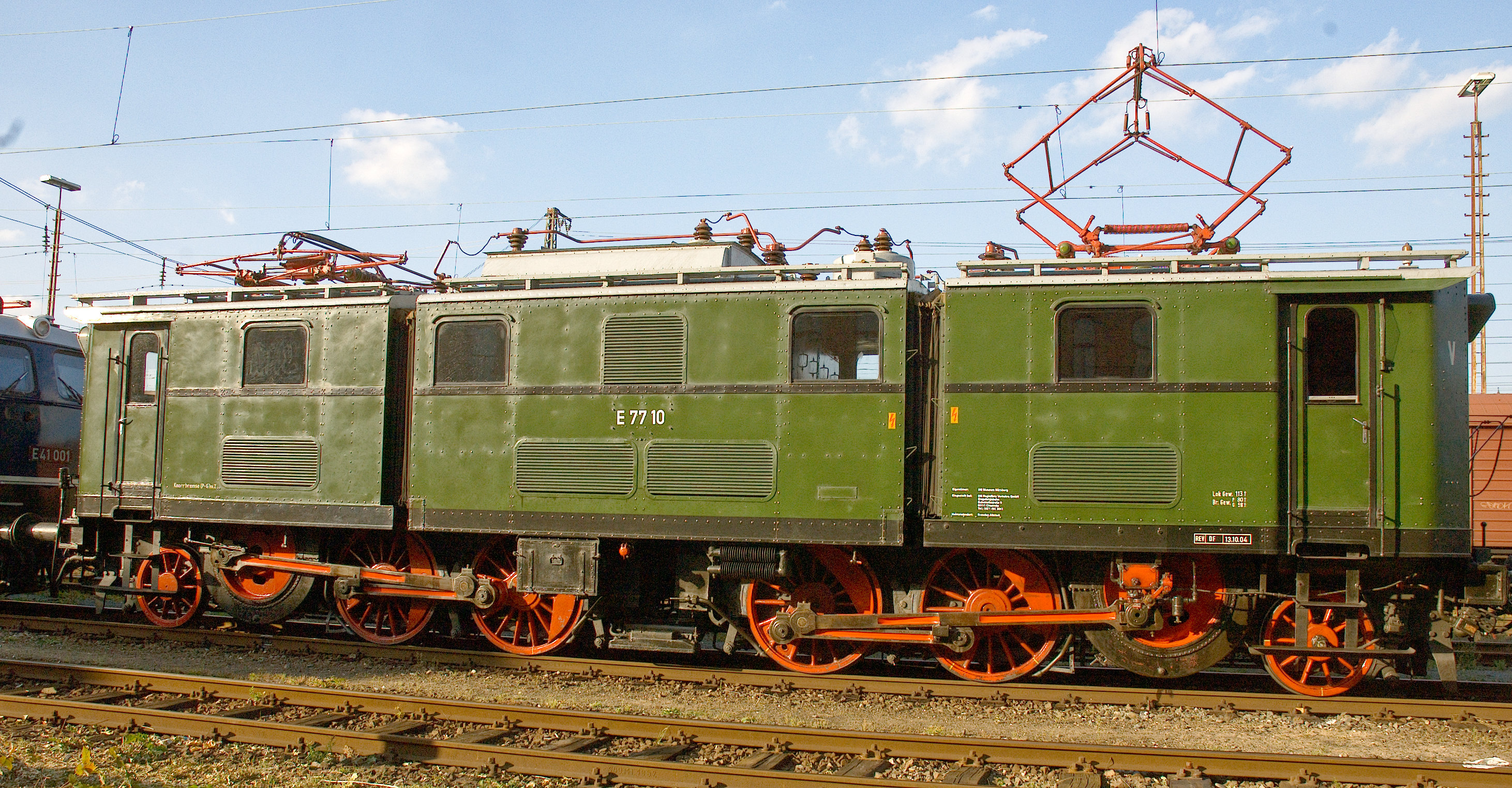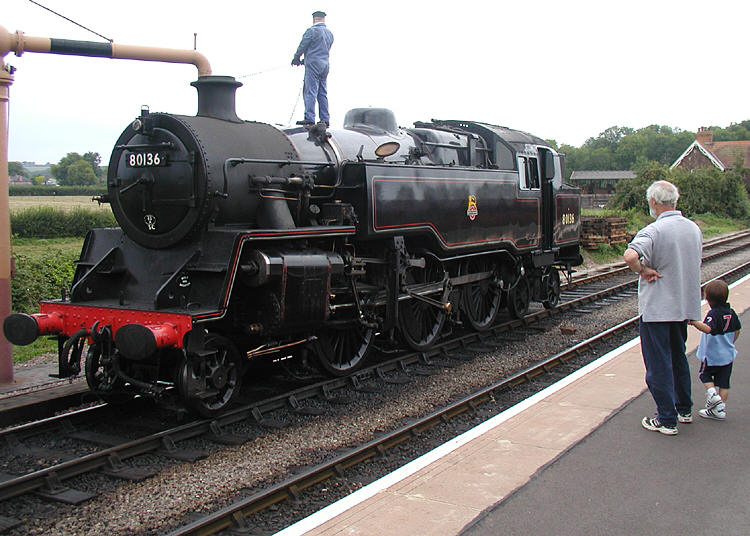|
DRG Class E 77
The German DRG Class E 77 was a Deutsche Reichsbahn-Gesellschaft electric locomotive class, which was ordered in 1923 and entered service in 1924. The 56 units of this class were specifically intended for the Halle (Saale) - Leipzig line and for routes in southern Germany. Pre-war period The E 77 had been designated a light multi-purpose locomotive within DRG's first classification programme. Later it was mainly used on freight trains. The engines were delivered by BMAG, Krauss and LHW and had originally still held the State Railways' Class EG 3 title with numbers 22 001 through 031 ( Bavarian) or EG 701 to 725 ( Prussian). BMS delivered the electrical parts. In service, the E 77 distinguished itself with a rather limited result. One was never really satisfied with its running abilities. Moreover, there were often problems due to the many flexible electric cables. During World War II all engines ended at the ''Reichsbahndirektionen'' Halle und Hanover in exchange for Clas ... [...More Info...] [...Related Items...] OR: [Wikipedia] [Google] [Baidu] |
Berliner Maschinenbau
Berliner Maschinenbau AG was a German manufacturer of locomotives. The factory was founded by Louis Victor Robert Schwartzkopff on 3 October 1852 as ''Eisengießerei und Maschinen-Fabrik von L. Schwartzkopff'' in Berlin. History The factory was founded on 3 October 1852 as ''Eisengießerei und Maschinen-Fabrik von L. Schwartzkopff'' in Berlin by Louis Victor Robert Schwartzkopff. After a fire in 1860 and the expansion of the factory, they started to manufacture turntables, water systems and turnouts for several railway companies. The first locomotive built by the firm was delivered on 1 February 1867 to the Lower Silesian-Mark Railway (''Niederschlesisch-Märkische Eisenbahn'' or NME). On 1 July 1870 the firm was turned into a share company and renamed the ''Berliner Maschinenbau-Actien-Gesellschaft vormals L. Schwartzkopff, Berlin''. In 1897 a second factory was opened in Wildau. From 1899 the company also manufactured Linotype machines for the Mergenthaler factory ... [...More Info...] [...Related Items...] OR: [Wikipedia] [Google] [Baidu] |
Reichsbahndirektion
In Germany and Austria, the running of railway services for a railway administration or the regional network of a large railway company was devolved to railway divisions, variously known as ''Eisenbahndirektionen (ED), Bundesbahndirektionen (BD)'' or ''Reichsbahndirektionen (RBD/Rbd)''. Their organisation was determined by the railway company concerned or by the state railway and, in the German-speaking lands at least, they formed the intermediate authorities and regional management organisations within the state railway administration's hierarchy. On the formation of the Deutsche Bahn AG in 1994 the system of railway divisions (''Eisenbahndirektionen'') in Germany was discontinued and their tasks were transferred to new "business areas". Germany State railway divisions Incorporation into the state government The first railway divisions of the various German state railways (known as ''Länderbahnen''), usually reported to a specific government ministry. For example, in Pruss ... [...More Info...] [...Related Items...] OR: [Wikipedia] [Google] [Baidu] |
Deutsche Reichsbahn-Gesellschaft Locomotives
Deutsch or Deutsche may refer to: *''Deutsch'' or ''(das) Deutsche'': the German language, in Germany and other places *''Deutsche'': Germans, as a weak masculine, feminine or plural demonym *Deutsch (word), originally referring to the Germanic vernaculars of the Early Middle Ages Businesses and organisations *André Deutsch, an imprint of Carlton Publishing Group *Deutsch Inc., a former American advertising agency that split in 2020 into: ** Deutsch NY, a New York City-based advertising agency * Deutsche Aerospace AG *Deutsche Akademie, a cultural organisation, superseded by the Goethe-Institut *Deutsche Bahn, the German railway service *Deutsche Bank *Deutsche Börse, a German stock exchange * Deutsche Geophysikalische Gesellschaft, the German Geophysical Society *Deutsche Grammophon, a German classical music record label *Deutsch Group, an international connector manufacturer *Deutsche Luft Hansa (1926–1945) * Deutsche Lufthansa (since 1953), an airline *Deutsche Marine, t ... [...More Info...] [...Related Items...] OR: [Wikipedia] [Google] [Baidu] |
List Of Bavarian Locomotives And Railbuses
A ''list'' is any set of items in a row. List or lists may also refer to: People * List (surname) Organizations * List College, an undergraduate division of the Jewish Theological Seminary of America * SC Germania List, German rugby union club Other uses * Angle of list, the leaning to either port or starboard of a ship * List (information), an ordered collection of pieces of information ** List (abstract data type), a method to organize data in computer science * List on Sylt, previously called List, the northernmost village in Germany, on the island of Sylt * ''List'', an alternative term for ''roll'' in flight dynamics * To ''list'' a building, etc., in the UK it means to designate it a listed building that may not be altered without permission * Lists (jousting), the barriers used to designate the tournament area where medieval knights jousted * ''The Book of Lists'', an American series of books with unusual lists See also * The List (other) * Listing ... [...More Info...] [...Related Items...] OR: [Wikipedia] [Google] [Baidu] |
List Of DRG Locomotives And Railbuses
The railway vehicle classes covered by this list of DRG locomotives and railbuses belonged to the ''Deutsche Reichsbahn-Gesellschaft'' or DRG (1924–37) and its successor, the ''Deutsche Reichsbahn'' or DRB (post 1937). The DRG (lit. German Imperial Railway Company) was formed under the terms of the Dawes Plan from the ''Deutsche Reichseisenbahnen'' (lit. Imperial Railways), a merger of the various German state railways after the First World War. The tables are generally organized in accordance with the DRG's numbering schemes for the various types of vehicles. A brief explanation of this may be found in the articles on the numbering scheme of the German railways and German steam locomotive classification. After the end of the Second World War the West German part of the DRB became the ''Deutsche Bundesbahn'' (DB), but its East German counterpart continued to be called the ''Deutsche Reichsbahn'' (DR) – see Deutsche Reichsbahn (East Germany). The DB and the DR later introduc ... [...More Info...] [...Related Items...] OR: [Wikipedia] [Google] [Baidu] |
List Of DB Locomotives And Railbuses
This list provides an overview of the motive power operated by Deutsche Bahn. It only includes those vehicles that have been in service with the Deutsche Bahn AG since its formation on 1 January 1994. The classes are numbered according to the locomotive classification of the Deutsche Bundesbahn, which had been adopted by Deutsche Bahn in 1994. Since 2007, classifications for all German railway companies are centrally issued by the Federal Railway Office in line with UIC classification rules. Steam locomotives Several narrow gauge steam locomotives were taken over by Deutsche Bahn, which until 2004 were handed over to communal services or heritage railways. Electric locomotives Diesel locomotives Minor locomotives Electric multiple units Accumulator Cars Diesel multiple units Railway works vehicles See also *Deutsche Bahn *UIC identification marking for tractive stock {{German locomotives Locomotives of German ... [...More Info...] [...Related Items...] OR: [Wikipedia] [Google] [Baidu] |
Dresden Transport Museum
The Dresden Transport Museum ( German: Verkehrsmuseum Dresden) displays vehicles of all modes of transport, such as railway, shipping, road and air traffic, under one roof. The museum is housed in the Johanneum at the Neumarkt in Dresden. The Johanneum was built between 1586 and 1590; it is one of the oldest museum buildings in Dresden.Fritz Löffler: ''Das alte Dresden - Geschichte seiner Bauten''. 16th ed. Leipzig: Seemann, 2006, History The history of the Dresden Transport Museum begins on 1 May 1952. On that day, negotiations started between the Hochschule für Verkehrswesen (High School for Transportation) and the Ministry of Transport for the construction of a transport museum in the German Democratic Republic. The museum was mainly intended to house the exhibits of the Saxon Railway Museum that had been evacuated during the Second World War. After Dresden was confirmed as the location, the first vehicles were stabled in a locomotive shed at Dresden's Neustadt ... [...More Info...] [...Related Items...] OR: [Wikipedia] [Google] [Baidu] |
Permille
Per mille (from Latin , "in each thousand") is an expression that means parts per thousand. Other recognised spellings include per mil, per mill, permil, permill, or permille. The associated sign is written , which looks like a percent sign with an extra zero or o in the divisor. The term occurs so rarely in English that major dictionaries do not agree on the spelling and some major dictionaries such as '' Macmillan'' do not even contain an entry. The term is more common in other European languages where it is used to express fractions smaller than 1%. One common usage is blood alcohol content, which is usually expressed as a percentage in English-speaking countries. Per mille should not be confused with parts per million (ppm). Computer systems The code point for the glyph is included in the General Punctuation block of Unicode characters: .Unicode.General Punctuation. 2014. Accessed 5 Aug 2014. It may be typed using , , , or according to operating system. Note that ... [...More Info...] [...Related Items...] OR: [Wikipedia] [Google] [Baidu] |
Wheel Arrangement
In rail transport, a wheel arrangement or wheel configuration is a system of classifying the way in which wheels are distributed under a locomotive. Several notations exist to describe the wheel assemblies of a locomotive by type, position, and connections, with the adopted notations varying by country. Within a given country, different notations may also be employed for different kinds of locomotives, such as steam, electric, and diesel powered. Especially in steam days, wheel arrangement was an important attribute of a locomotive because there were many different types of layout adopted, each wheel being optimised for a different use (often with only some being actually "driven"). Modern diesel and electric locomotives are much more uniform, usually with all axles driven. Major notation schemes The main notations are the Whyte notation (based on counting the wheels), the AAR wheel arrangement notation (based on counting either the axles or the bogies), and the UIC class ... [...More Info...] [...Related Items...] OR: [Wikipedia] [Google] [Baidu] |
Heritage Railway
A heritage railway or heritage railroad (US usage) is a railway operated as living history to re-create or preserve railway scenes of the past. Heritage railways are often old railway lines preserved in a state depicting a period (or periods) in the history of rail transport. Definition The British Office of Rail and Road defines heritage railways as follows:...'lines of local interest', museum railways or tourist railways that have retained or assumed the character and appearance and operating practices of railways of former times. Several lines that operate in isolation provide genuine transport facilities, providing community links. Most lines constitute tourist or educational attractions in their own right. Much of the rolling stock and other equipment used on these systems is original and is of historic value in its own right. Many systems aim to replicate both the look and operating practices of historic former railways companies. Infrastructure Heritage railway line ... [...More Info...] [...Related Items...] OR: [Wikipedia] [Google] [Baidu] |
Deutsche Reichsbahn (East Germany)
The Deutsche Reichsbahn or DR ''(German Reich Railways)'' was the operating name of state owned railways in the German Democratic Republic (East Germany), and after German reunification until 1 January 1994. In 1949, occupied Germany's railways were returned to German control after four years of Allied control following World War II. Those in the Soviet occupation zone (which became the German Democratic Republic or GDR on 7 October 1949) continued to run as the Deutsche Reichsbahn, the name given to the German national railways in 1937. In West Germany, the Reichsbahn was succeeded by the Deutsche Bundesbahn (DB). Both the Reichsbahn and the Bundesbahn continued as separate entities until 1994, when they merged to form the Deutsche Bahn. Organisation The DR was the largest employer in the GDR and as a state-owned firm was directly subordinated to the GDR Ministry of Transport ''(Ministerium für Verkehr der DDR)''. From November 1954 until November 1989, the GDR Minist ... [...More Info...] [...Related Items...] OR: [Wikipedia] [Google] [Baidu] |







